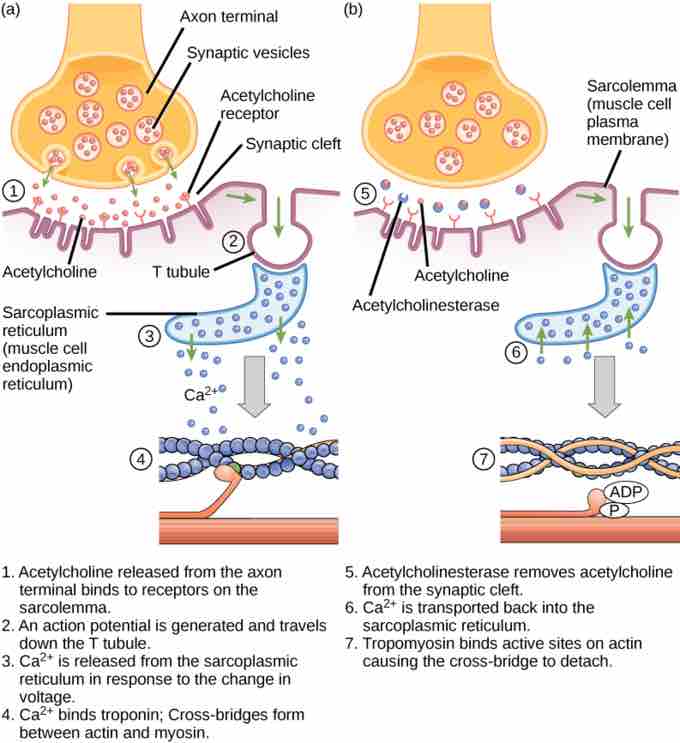Excitation–Contraction Coupling
Excitation–contraction coupling is the physiological process of converting an electrical stimulus to a mechanical response. It is the link (transduction) between the action potential generated in the sarcolemma and the start of a muscle contraction .

Excitation-contraction coupling
This diagram shows excitation-contraction coupling in a skeletal muscle contraction. The sarcoplasmic reticulum is a specialized endoplasmic reticulum found in muscle cells.
Communication between Nerves and Muscles
A neural signal is the electrical trigger for calcium release from the sarcoplasmic reticulum into the sarcoplasm. Each skeletal muscle fiber is controlled by a motor neuron, which conducts signals from the brain or spinal cord to the muscle. Electrical signals called action potentials travel along the neuron's axon, which branches through the muscle, connecting to individual muscle fibers at a neuromuscular junction. The area of the sarcolemma on the muscle fiber that interacts with the neuron is called the motor-end plate. The end of the neuron's axon is called the synaptic terminal; it does not actually contact the motor-end plate. A small space called the synaptic cleft separates the synaptic terminal from the motor-end plate.
Because neuron axons do not directly contact the motor-end plate, communication occurs between nerves and muscles through neurotransmitters. Neuron action potentials cause the release of neurotransmitters from the synaptic terminal into the synaptic cleft, where they can then diffuse across the synaptic cleft and bind to a receptor molecule on the motor end plate. The motor end plate possesses junctional folds: folds in the sarcolemma that create a large surface area for the neurotransmitter to bind to receptors. The receptors are sodium channels that open to allow the passage of Na+ into the cell when they receive neurotransmitter signal.
Depolarization in the Sarcolemma
Acetylcholine (ACh) is a neurotransmitter released by motor neurons that binds to receptors in the motor end plate. Neurotransmitter release occurs when an action potential travels down the motor neuron's axon, resulting in altered permeability of the synaptic terminal membrane and an influx of calcium. The Ca2+ ions allow synaptic vesicles to move to and bind with the presynaptic membrane (on the neuron) and release neurotransmitter from the vesicles into the synaptic cleft. Once released by the synaptic terminal, ACh diffuses across the synaptic cleft to the motor end plate, where it binds with ACh receptors.
As a neurotransmitter binds, these ion channels open, and Na+ ions cross the membrane into the muscle cell. This reduces the voltage difference between the inside and outside of the cell, which is called depolarization. As ACh binds at the motor end plate, this depolarization is called an end-plate potential. The depolarization then spreads along the sarcolemma and down the T tubules, creating an action potential. The action potential triggers the sarcoplasmic reticulum to release of Ca2+, which activate troponin and stimulate muscle contraction.
ACh is broken down by the enzyme acetylcholinesterase (AChE) into acetyl and choline. AChE resides in the synaptic cleft, breaking down ACh so that it does not remain bound to ACh receptors, which would cause unwanted extended muscle contraction.